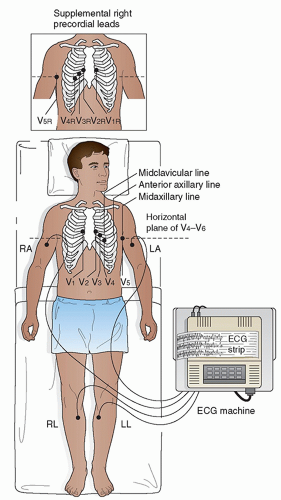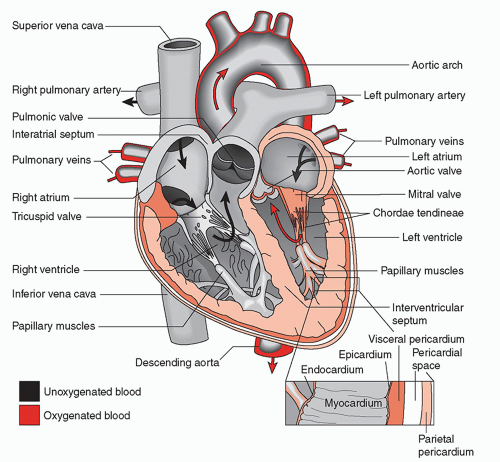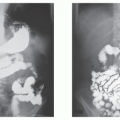Basic Electrocardiogram Monitoring
OBJECTIVES
After studying this chapter, the student will be able to:
1. Briefly explain the cardiac conduction system.
2. Correctly apply the three lead cardiac monitoring electrodes.
3. Identify electrocardiogram waveform components.
4. Recognize ominous cardiac arrhythmias.
5. Explain the role of a radiographer in responding to ominous arrhythmias.
KEY TERMS
Angina: A severe, often constricting pain or sensation of pressure, usually referring to angina pectoris
Arrhythmia: Loss of rhythm; an irregularity of the heartbeat
Atrium: Atria (plural); a chamber or cavity to which are connected several chambers or passageways
Cardiogram: The tracing that depicts the heart’s electrical activity
Depolarization: Process by which cardiac muscle cells change from a more negatively charged to a more positively charged intracellular state
Dysrhythmia: A disorder of the formation or conduction of the electrical impulses in the heart that alters the heart rate or rhythm or both
Hemodynamic: Factor affecting the force and flow of circulating blood
Interventricular: Septal branches of left-right coronary artery; the interventricular septal branches: branches of the anterior and posterior interventricular arteries distributed to the muscle of the interventricular septum
Mediastinum: A septum between two pleural cavities containing all the thoracic structures except the lungs and pleurae
Myocardial infarction: Death of heart tissue resulting from lack of oxygenated blood flow
Myocardial ischemia: Insufficient oxygenation of the tissues of the heart muscle
Myocardium: The middle muscular layer of the heart
Myocytes: Muscle cells
Normal sinus rhythm: The pacing impulse begins in the sinus node and travels normally down the electrical conduction pathways
Oscilloscope: The screen on which electrocardiogram patterns appear
Repolarization: Cardiac muscle cells return to a more negatively charged intracellular condition (their resting state)
Septum: A thin wall dividing two cavities
Thrombi: Collections of platelets, fibrin, and clotting factors that attach to the interior wall of a vein and may result in occlusion of a vessel
Ventricle: A normal cavity, as of the heart
In the mid-1880s, it was discovered that the heart’s electrical activity could be measured externally by placing an electrode on a person’s skin. In 1901, Dr. Willem Einthoven improved on this initial discovery and devised a means of measuring the heart’s electrical activity with a timed record. He named these measured waves or rhythmic movements the P, QRS, and T waves, and named the tracing of these movements electrokardiogram (EKG). In many circles, it is still known as an EKG. In English language, we spell cardiogram with a c, and call this measurement the electrical activity of the heart an electrocardiogram (ECG). It will be known in this text as an ECG; however, EKG and ECG are the same.
The technologist will participate in many diagnostic procedures that require continuous cardiac monitoring to recognize ominous ECG patterns as they appear on the screen of an oscilloscope.
An ECG records the electrical activity of the heart, thereby providing a record of the heart’s electrical activity and information concerning the heart’s function and structure. As the heart is monitored, a tracing of its electrical activity is made on electrically sensitive paper or on the screen of an oscilloscope. This tracing is used to detect abnormal transmission of cardiac impulses from the heart through the surrounding tissues to the skin surface. When the impulses reach the skin, electrodes that have been placed in standardized anatomic positions transmit them to the ECG machine, and the impulses are then recorded in graphic form (Fig. 17-1).
ECG readings that seem abnormal are not necessarily indicative of heart disease. Conversely, a normal ECG pattern is not always an indication that the heart is healthy. The ECG cannot detect all pathologic cardiac conditions.
There are several types of ECG testing. They require that electrodes be placed in varying numbers on the exterior body. A radiographer who must learn this subject in detail must plan to enroll in a special class for this purpose, which includes clinical practice in learning to read ECG rhythm strips. Continuous monitoring with the patient connected to a cardiac oscilloscope is the type of ECG to which the radiographer will most often be exposed. Blood pressure, respiratory rate, and oxygen saturation are also continuously monitored and displayed on the oscilloscope. If the patient’s heart rate, rhythm, or other vital signs deviate from the normal rate or rhythm, an alarm sounds to alert the team caring for the patient. In this manner, life-threatening problems are detected instantly. A printout of the ECG pattern is made at specified times for the patient’s record to compare the current pattern with previous patterns on each patient. The radiographer must be able to manually assess the patient’s vital signs and visible signs of distress in emergency situations because he may be the first to detect a problem.
A REVIEW OF CARDIAC ANATOMY
The heart is a fist-sized muscular organ that is located in the left side of the body between the lungs and the mediastinum. It is a double pump. Its purpose is to pump deoxygenated blood through the heart to the lungs for reoxygenation and then to pump reoxygenated blood back through the heart into the aorta and ultimately to all body tissues. The student will recall that the heart has four chambers: the right and left atria and the right and left ventricles. The apex of the heart is at the lowest aspect of the organ, and the base of the heart is the upper aspect. The right and left ventricles of the heart are separated by the interventricular septum. The chambers of the heart are protected from re-entry of blood that has been pumped from one chamber of the heart to another by a series of valves. The walls of the atria and
ventricles are composed of three layers: the epicardium (the thin outer layer), the myocardium (the middle muscular layer), and the endocardium (the thin inner layer). The muscular layer of the atria is thinner than that of the ventricles. The blood flow through the heart is as follows:
ventricles are composed of three layers: the epicardium (the thin outer layer), the myocardium (the middle muscular layer), and the endocardium (the thin inner layer). The muscular layer of the atria is thinner than that of the ventricles. The blood flow through the heart is as follows:
1. Deoxygenated blood flows into the right atrium
from the inferior and superior vena cava and veins draining into the heart.
2. It is then pumped through the tricuspid valve into the right ventricle.
3. The contraction of the right ventricle sends deoxygenated blood through the pulmonic (semilunar) valve into the lungs for reoxygenation through the pulmonary artery.
4. The oxygenated blood then flows through the pulmonary veins into the left atrium.
5. The contraction of the left atrium pumps the blood from the left atrium through the mitral (bicuspid) valve into the left ventricle.
6. The left ventricle then contracts, and oxygenated blood is pumped into the aorta and then to all parts of the body.
The myocardium (the heart muscle) is supplied with oxygenated blood through the right and left coronary arteries and their branches. The branches of the left coronary artery supply the interventricular septum, the walls and surfaces of the atria and ventricles, and the sinoatrial (SA) and atrioventricular (AV) nodes. The right coronary artery supplies the remainder of the myocardial blood supply (Fig. 17-2).
THE CARDIAC CONDUCTION SYSTEM
The ECG reports the electrical activity of the heart, particularly the contraction of the myocardium. It also supplies information concerning the heart’s rate and rhythm. Electrical stimulation results in contraction of the heart. The cells of the heart muscle (myocytes) are influenced by sodium, calcium, and potassium ions. At rest, myocytes are polarized, and the interior of the cells is negatively charged. When they are depolarized, the interior of the myocytes become positive. When an electrical impulse is initiated, potassium rushes out of the myocytes and sodium rushes in. Calcium also enters the cells at this stage, but at
a slower rate, and acts as a regulator of cardiac contraction. This initiates depolarization and converts the electrical charge of the cell into a positive charge. Depolarization acts as a wave throughout the myocardium and results in contraction of the heart. Repolarization takes place as the cells return to a resting state.
a slower rate, and acts as a regulator of cardiac contraction. This initiates depolarization and converts the electrical charge of the cell into a positive charge. Depolarization acts as a wave throughout the myocardium and results in contraction of the heart. Repolarization takes place as the cells return to a resting state.
The conduction system of the heart has myocardial cells that have the properties of automaticity, conductivity, excitability, and contractility. The SA node, located in the upper posterior wall of the right atrium, is the dominant pacemaker of the heart. At rest under normal conditions, the SA node initiates 60 to 100 impulses per minute. It is responsible for the rate and rhythm of the cardiac cycle or the automaticity.
DISPLAY 17-1 Normal Cardiac Cycle
1. From the SA node, the wave of depolarization is carried through to the right atrium to the left atrium and results in nearly simultaneous contraction of the right and left atria.
2. The atrial conduction system has three internodal tracts in the right atrium (anterior, middle, and posterior) and one conduction tract in the left atrium called Bachmann’s bundle, which depolarizes the left atrium.
3. Depolarization is then conducted to the AV node. The AV node is located in the right atrial wall near the tricuspid valve and coordinates the incoming electrical impulses from the atria.
4. After a brief delay during which the atria contracts and completes filling the ventricles, the impulse is conducted to the bundle of His.
5. The bundle of His is a group of cells that travels through the ventricular septum. It divides into the right and left bundle branches and conducts impulses to the right and left ventricles.
6. The left bundle branch bifurcates into the left anterior and left posterior bundle branches to reach the terminal point in the conduction system, the Purkinje fibers.
Stay updated, free articles. Join our Telegram channel

Full access? Get Clinical Tree







